Organisational Learning and Learning Organisations: A Detailed Report
VerifiedAdded on 2022/12/27
|11
|3245
|59
Report
AI Summary
This report comprehensively examines the concepts of organisational learning and learning organisations. It begins by defining learning and development, emphasizing their role in enhancing employee skills and performance. The report delves into organisational learning, highlighting its importance in knowledge creation, retention, and transfer within an organisation. It explores the organisational learning theory, emphasizing the role of interaction and knowledge sharing. The report also outlines the advantages and disadvantages of organisational learning and presents the Organisational Learning Model (Argyris and Schon, 1996), including single, double, and deutero learning loops. The report further defines learning organisations, emphasizing their adaptability and continuous learning capabilities. It details the features of learning organisations, such as boundary-less structures, teamwork, and information sharing, and discusses their advantages and disadvantages. The relationship between organisational learning and learning organisations is explored, along with a comparison of their key differences. This report aims to provide a clear understanding of these concepts and their implications for organisational success.
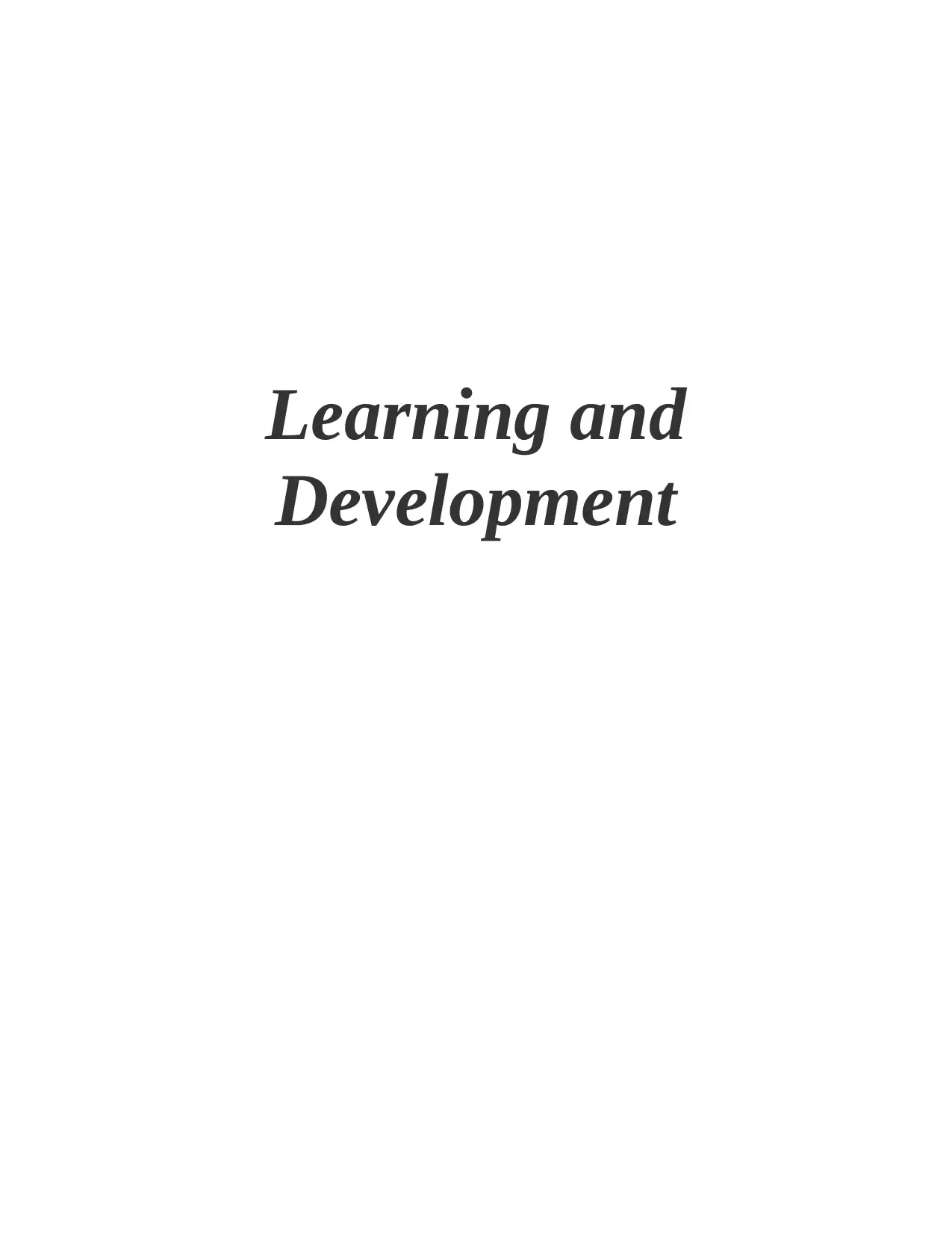
Learning and
Development
Development
Paraphrase This Document
Need a fresh take? Get an instant paraphrase of this document with our AI Paraphraser
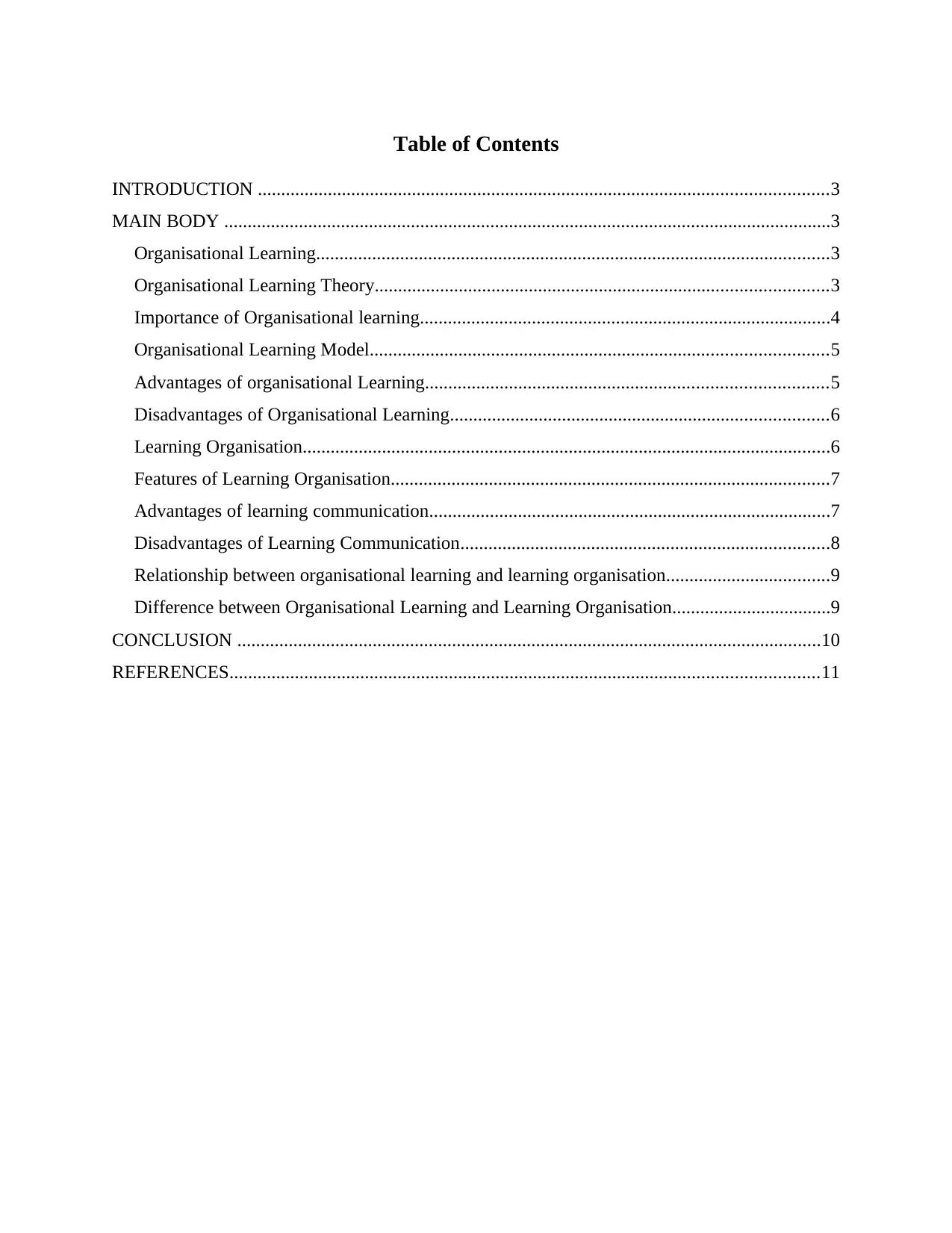
Table of Contents
INTRODUCTION ..........................................................................................................................3
MAIN BODY ..................................................................................................................................3
Organisational Learning..............................................................................................................3
Organisational Learning Theory.................................................................................................3
Importance of Organisational learning........................................................................................4
Organisational Learning Model..................................................................................................5
Advantages of organisational Learning......................................................................................5
Disadvantages of Organisational Learning.................................................................................6
Learning Organisation.................................................................................................................6
Features of Learning Organisation..............................................................................................7
Advantages of learning communication......................................................................................7
Disadvantages of Learning Communication...............................................................................8
Relationship between organisational learning and learning organisation...................................9
Difference between Organisational Learning and Learning Organisation..................................9
CONCLUSION .............................................................................................................................10
REFERENCES..............................................................................................................................11
INTRODUCTION ..........................................................................................................................3
MAIN BODY ..................................................................................................................................3
Organisational Learning..............................................................................................................3
Organisational Learning Theory.................................................................................................3
Importance of Organisational learning........................................................................................4
Organisational Learning Model..................................................................................................5
Advantages of organisational Learning......................................................................................5
Disadvantages of Organisational Learning.................................................................................6
Learning Organisation.................................................................................................................6
Features of Learning Organisation..............................................................................................7
Advantages of learning communication......................................................................................7
Disadvantages of Learning Communication...............................................................................8
Relationship between organisational learning and learning organisation...................................9
Difference between Organisational Learning and Learning Organisation..................................9
CONCLUSION .............................................................................................................................10
REFERENCES..............................................................................................................................11

INTRODUCTION
Learning and development is a process which is systematically done that helps in
enhancing the skills of the employees, their knowledge and also their competency which results
in their better performance in an organisation (Broström, 2017). Learning basically helps in
acquiring the knowledge, attitude and also skills. Development basically is the way in which the
said knowledge is broadened and deepened with help of various goals of development. The main
aim of the learning and development is that it is very useful in developing or changing the
behaviours of the individuals or teams for better. It also enables sharing of knowledge and
insights so that their work can be improved along with their performances. This report explains
the Organisational learning and the learning organisations. It also critically examines the
difference between both of them.
MAIN BODY
Organisational Learning
This type of learning is very important for the companies as it is a process which creates,
retains and transfer the knowledge that helps in strengthening the organisation. This process is
termed to be very important for the organisation as it helps in ensuring that the knowledge gained
is transferred to the individuals of the organisation and also is retained within the organisation.
The knowledge so retained by the individuals cannot be retained for the long duration as
when they will leave the organisation, they will take such retained knowledge with them. Only
embedded knowledge in the organisation can be retained, kept and shared with the working
individuals (Al Kalbani, 2020).
Organisational Learning Theory
This is the theory which mainly focuses on creation of knowledge and then using the
same in the organisation. The key aspect of this theory is that: learning happens only when there
is interaction between the people while they try to find solution to any problem. According to the
organisational learning theory, an organisation should:
Develop such a culture in organisation that encourages and motivates sharing of
knowledge via prizes.
Take time in learning the lessons which is taught by failures.
Learning and development is a process which is systematically done that helps in
enhancing the skills of the employees, their knowledge and also their competency which results
in their better performance in an organisation (Broström, 2017). Learning basically helps in
acquiring the knowledge, attitude and also skills. Development basically is the way in which the
said knowledge is broadened and deepened with help of various goals of development. The main
aim of the learning and development is that it is very useful in developing or changing the
behaviours of the individuals or teams for better. It also enables sharing of knowledge and
insights so that their work can be improved along with their performances. This report explains
the Organisational learning and the learning organisations. It also critically examines the
difference between both of them.
MAIN BODY
Organisational Learning
This type of learning is very important for the companies as it is a process which creates,
retains and transfer the knowledge that helps in strengthening the organisation. This process is
termed to be very important for the organisation as it helps in ensuring that the knowledge gained
is transferred to the individuals of the organisation and also is retained within the organisation.
The knowledge so retained by the individuals cannot be retained for the long duration as
when they will leave the organisation, they will take such retained knowledge with them. Only
embedded knowledge in the organisation can be retained, kept and shared with the working
individuals (Al Kalbani, 2020).
Organisational Learning Theory
This is the theory which mainly focuses on creation of knowledge and then using the
same in the organisation. The key aspect of this theory is that: learning happens only when there
is interaction between the people while they try to find solution to any problem. According to the
organisational learning theory, an organisation should:
Develop such a culture in organisation that encourages and motivates sharing of
knowledge via prizes.
Take time in learning the lessons which is taught by failures.
⊘ This is a preview!⊘
Do you want full access?
Subscribe today to unlock all pages.

Trusted by 1+ million students worldwide

Encourage all the employees working in an organisation at various levels to continue
with their education.
Allow the individuals working in the organisation to challenge its status quo.
Importance of Organisational learning
Organisational learning has many importance with the help of which the companies
develop their learning culture. Few of the main importance of the organisational learning are
given below:
It helps in increasing the job satisfaction of the employees.
It helps in lowering down the turnover rate (Kumar and Sudan, 2017).
It helps in increasing the productivity of the company along with the profits and the
efficiency of the company is also increased.
It helps in the development of the leaders present at all the various levels in an
organisation.
It helps in the enhancement of the adaptability within the organisation.
When any organisation is engaged in its own development by enhancing its knowledge
and implementing the same in the organisation by dedicating its most of the time and resources,
it gets very competitive in nature.
All the importance stated above will enhance the growth and success of an organisation
along with the enhancement of the knowledge of the individuals working in that organisation.
The knowledge is learnt by the individuals either by solving various problems in groups or
individually. The knowledge is also gained by the employees of the organisation by learning
through the failures and mistakes.
Both employee and the employer of an organisation contribute in this process and share
equally all the information that further helps in the contribution of each of the individual in a
manner which is substantial (Taylor and Antonacopoulou, 2019).
with their education.
Allow the individuals working in the organisation to challenge its status quo.
Importance of Organisational learning
Organisational learning has many importance with the help of which the companies
develop their learning culture. Few of the main importance of the organisational learning are
given below:
It helps in increasing the job satisfaction of the employees.
It helps in lowering down the turnover rate (Kumar and Sudan, 2017).
It helps in increasing the productivity of the company along with the profits and the
efficiency of the company is also increased.
It helps in the development of the leaders present at all the various levels in an
organisation.
It helps in the enhancement of the adaptability within the organisation.
When any organisation is engaged in its own development by enhancing its knowledge
and implementing the same in the organisation by dedicating its most of the time and resources,
it gets very competitive in nature.
All the importance stated above will enhance the growth and success of an organisation
along with the enhancement of the knowledge of the individuals working in that organisation.
The knowledge is learnt by the individuals either by solving various problems in groups or
individually. The knowledge is also gained by the employees of the organisation by learning
through the failures and mistakes.
Both employee and the employer of an organisation contribute in this process and share
equally all the information that further helps in the contribution of each of the individual in a
manner which is substantial (Taylor and Antonacopoulou, 2019).
Paraphrase This Document
Need a fresh take? Get an instant paraphrase of this document with our AI Paraphraser
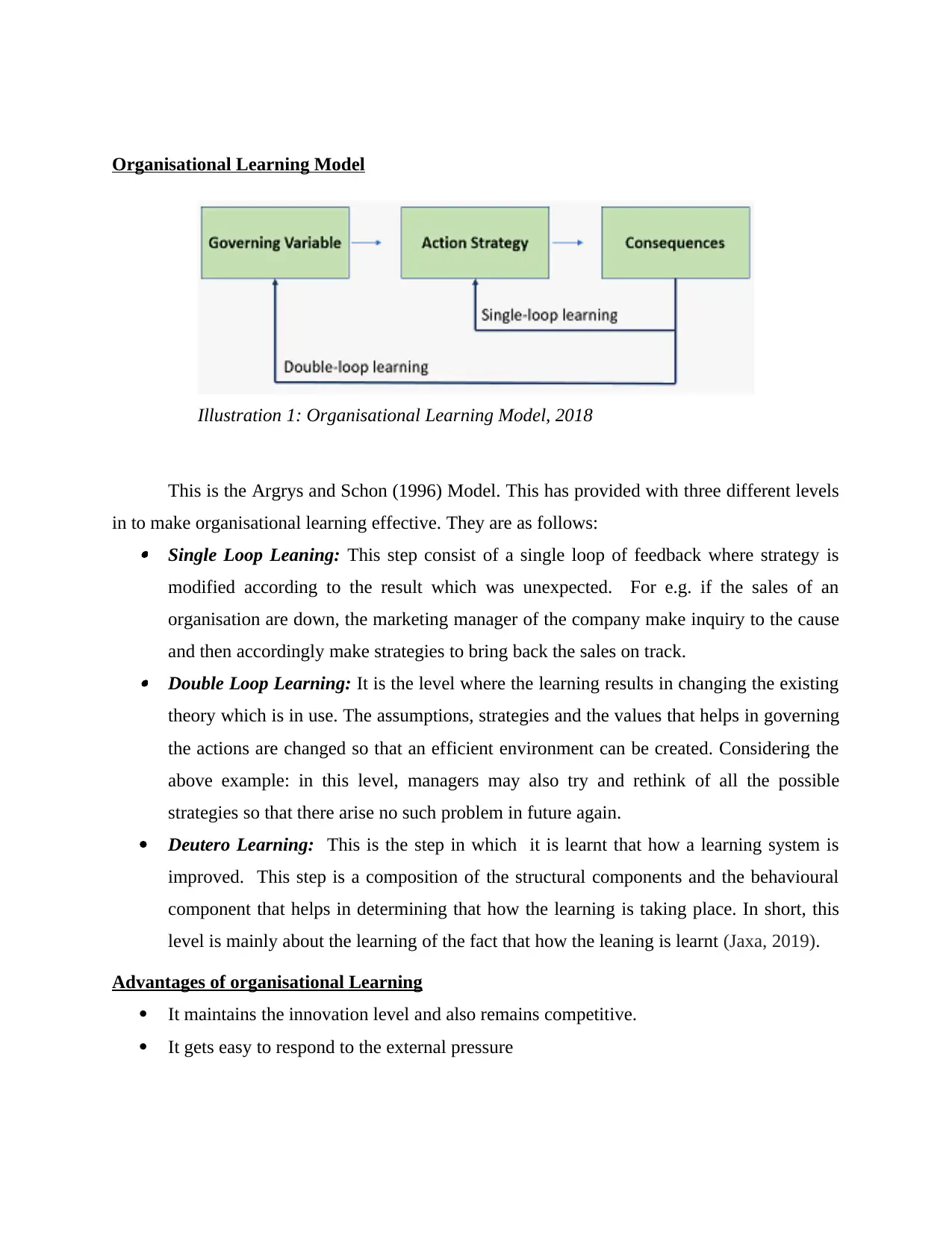
Organisational Learning Model
This is the Argrys and Schon (1996) Model. This has provided with three different levels
in to make organisational learning effective. They are as follows: Single Loop Leaning: This step consist of a single loop of feedback where strategy is
modified according to the result which was unexpected. For e.g. if the sales of an
organisation are down, the marketing manager of the company make inquiry to the cause
and then accordingly make strategies to bring back the sales on track. Double Loop Learning: It is the level where the learning results in changing the existing
theory which is in use. The assumptions, strategies and the values that helps in governing
the actions are changed so that an efficient environment can be created. Considering the
above example: in this level, managers may also try and rethink of all the possible
strategies so that there arise no such problem in future again.
Deutero Learning: This is the step in which it is learnt that how a learning system is
improved. This step is a composition of the structural components and the behavioural
component that helps in determining that how the learning is taking place. In short, this
level is mainly about the learning of the fact that how the leaning is learnt (Jaxa, 2019).
Advantages of organisational Learning
It maintains the innovation level and also remains competitive.
It gets easy to respond to the external pressure
Illustration 1: Organisational Learning Model, 2018
This is the Argrys and Schon (1996) Model. This has provided with three different levels
in to make organisational learning effective. They are as follows: Single Loop Leaning: This step consist of a single loop of feedback where strategy is
modified according to the result which was unexpected. For e.g. if the sales of an
organisation are down, the marketing manager of the company make inquiry to the cause
and then accordingly make strategies to bring back the sales on track. Double Loop Learning: It is the level where the learning results in changing the existing
theory which is in use. The assumptions, strategies and the values that helps in governing
the actions are changed so that an efficient environment can be created. Considering the
above example: in this level, managers may also try and rethink of all the possible
strategies so that there arise no such problem in future again.
Deutero Learning: This is the step in which it is learnt that how a learning system is
improved. This step is a composition of the structural components and the behavioural
component that helps in determining that how the learning is taking place. In short, this
level is mainly about the learning of the fact that how the leaning is learnt (Jaxa, 2019).
Advantages of organisational Learning
It maintains the innovation level and also remains competitive.
It gets easy to respond to the external pressure
Illustration 1: Organisational Learning Model, 2018
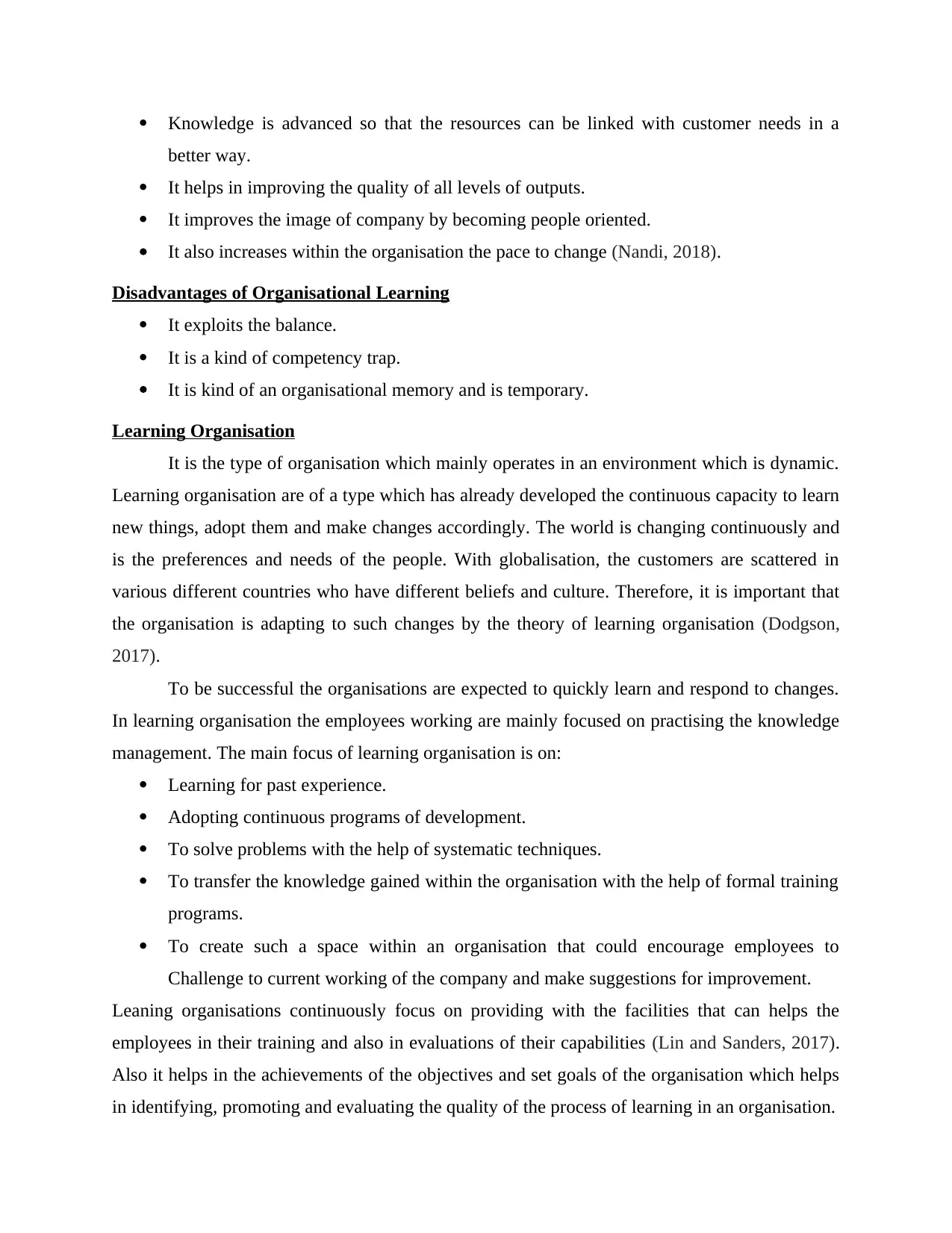
Knowledge is advanced so that the resources can be linked with customer needs in a
better way.
It helps in improving the quality of all levels of outputs.
It improves the image of company by becoming people oriented.
It also increases within the organisation the pace to change (Nandi, 2018).
Disadvantages of Organisational Learning
It exploits the balance.
It is a kind of competency trap.
It is kind of an organisational memory and is temporary.
Learning Organisation
It is the type of organisation which mainly operates in an environment which is dynamic.
Learning organisation are of a type which has already developed the continuous capacity to learn
new things, adopt them and make changes accordingly. The world is changing continuously and
is the preferences and needs of the people. With globalisation, the customers are scattered in
various different countries who have different beliefs and culture. Therefore, it is important that
the organisation is adapting to such changes by the theory of learning organisation (Dodgson,
2017).
To be successful the organisations are expected to quickly learn and respond to changes.
In learning organisation the employees working are mainly focused on practising the knowledge
management. The main focus of learning organisation is on:
Learning for past experience.
Adopting continuous programs of development.
To solve problems with the help of systematic techniques.
To transfer the knowledge gained within the organisation with the help of formal training
programs.
To create such a space within an organisation that could encourage employees to
Challenge to current working of the company and make suggestions for improvement.
Leaning organisations continuously focus on providing with the facilities that can helps the
employees in their training and also in evaluations of their capabilities (Lin and Sanders, 2017).
Also it helps in the achievements of the objectives and set goals of the organisation which helps
in identifying, promoting and evaluating the quality of the process of learning in an organisation.
better way.
It helps in improving the quality of all levels of outputs.
It improves the image of company by becoming people oriented.
It also increases within the organisation the pace to change (Nandi, 2018).
Disadvantages of Organisational Learning
It exploits the balance.
It is a kind of competency trap.
It is kind of an organisational memory and is temporary.
Learning Organisation
It is the type of organisation which mainly operates in an environment which is dynamic.
Learning organisation are of a type which has already developed the continuous capacity to learn
new things, adopt them and make changes accordingly. The world is changing continuously and
is the preferences and needs of the people. With globalisation, the customers are scattered in
various different countries who have different beliefs and culture. Therefore, it is important that
the organisation is adapting to such changes by the theory of learning organisation (Dodgson,
2017).
To be successful the organisations are expected to quickly learn and respond to changes.
In learning organisation the employees working are mainly focused on practising the knowledge
management. The main focus of learning organisation is on:
Learning for past experience.
Adopting continuous programs of development.
To solve problems with the help of systematic techniques.
To transfer the knowledge gained within the organisation with the help of formal training
programs.
To create such a space within an organisation that could encourage employees to
Challenge to current working of the company and make suggestions for improvement.
Leaning organisations continuously focus on providing with the facilities that can helps the
employees in their training and also in evaluations of their capabilities (Lin and Sanders, 2017).
Also it helps in the achievements of the objectives and set goals of the organisation which helps
in identifying, promoting and evaluating the quality of the process of learning in an organisation.
⊘ This is a preview!⊘
Do you want full access?
Subscribe today to unlock all pages.

Trusted by 1+ million students worldwide

Features of Learning Organisation
There are many features of leaning organisation. Few of them are discussed below: Boundary- less Organisation: It do not have any defined structure. There are no
boundaries set for this and the learning organisation is not structural and flexible. Teams: Employees are not made to work in some specific department or level. Rather
they work in a team in which they perform the activities of the organisation. Team work
enhance the knowledge and ability to widen thinking process to create new ideas. Information sharing: Learning is done by sharing information by one person to other or
to group of people. In organisation there is open sharing of thoughts and information
without any barrier in communication. Organisation also promote continuous learning
and sharing of knowledge and information (Samkin and Wingard, 2020). Shared Vision: The learning organisation have leaders that facilitates the shared vision in
an organisation. Employees of the organisation work for a common vision of the
company and collectively work for it in teams. It further provides employees with future
opportunities and also the benefits which they get from it. Collaboration: A very strong and a committed leader leads the learning organisation.
They help in collaborating employees with each other by supporting and encouraging
them to do so. This helps in motivating employees and they learn continuously from all
the influencing factors.
Organisational Culture: It is the system that helps in determining the behaviour of an
employee and how do they act. In this, employees mainly think about the process,
functioning, activities in an organisation that focus on inter-relationships.
Advantages of learning communication Open communication and sharing of information: The free flow of the knowledge and
information is very easily done in case when the internal ideas are encouraged to be
exchanged. As the learning organisation do not have a particular structure, information
can be accessed by all employees of the organisation (Holmwood, 2018). Innovativeness: The learning organisation have a culture that helps it by promoting and
encouraging to innovate. The organisation also grant freedom to its employees which
give them liberty to innovate new thing. The learning organisation helps in motivating
and encouraging both the employees and organisation to develop an innovate new things.
There are many features of leaning organisation. Few of them are discussed below: Boundary- less Organisation: It do not have any defined structure. There are no
boundaries set for this and the learning organisation is not structural and flexible. Teams: Employees are not made to work in some specific department or level. Rather
they work in a team in which they perform the activities of the organisation. Team work
enhance the knowledge and ability to widen thinking process to create new ideas. Information sharing: Learning is done by sharing information by one person to other or
to group of people. In organisation there is open sharing of thoughts and information
without any barrier in communication. Organisation also promote continuous learning
and sharing of knowledge and information (Samkin and Wingard, 2020). Shared Vision: The learning organisation have leaders that facilitates the shared vision in
an organisation. Employees of the organisation work for a common vision of the
company and collectively work for it in teams. It further provides employees with future
opportunities and also the benefits which they get from it. Collaboration: A very strong and a committed leader leads the learning organisation.
They help in collaborating employees with each other by supporting and encouraging
them to do so. This helps in motivating employees and they learn continuously from all
the influencing factors.
Organisational Culture: It is the system that helps in determining the behaviour of an
employee and how do they act. In this, employees mainly think about the process,
functioning, activities in an organisation that focus on inter-relationships.
Advantages of learning communication Open communication and sharing of information: The free flow of the knowledge and
information is very easily done in case when the internal ideas are encouraged to be
exchanged. As the learning organisation do not have a particular structure, information
can be accessed by all employees of the organisation (Holmwood, 2018). Innovativeness: The learning organisation have a culture that helps it by promoting and
encouraging to innovate. The organisation also grant freedom to its employees which
give them liberty to innovate new thing. The learning organisation helps in motivating
and encouraging both the employees and organisation to develop an innovate new things.
Paraphrase This Document
Need a fresh take? Get an instant paraphrase of this document with our AI Paraphraser
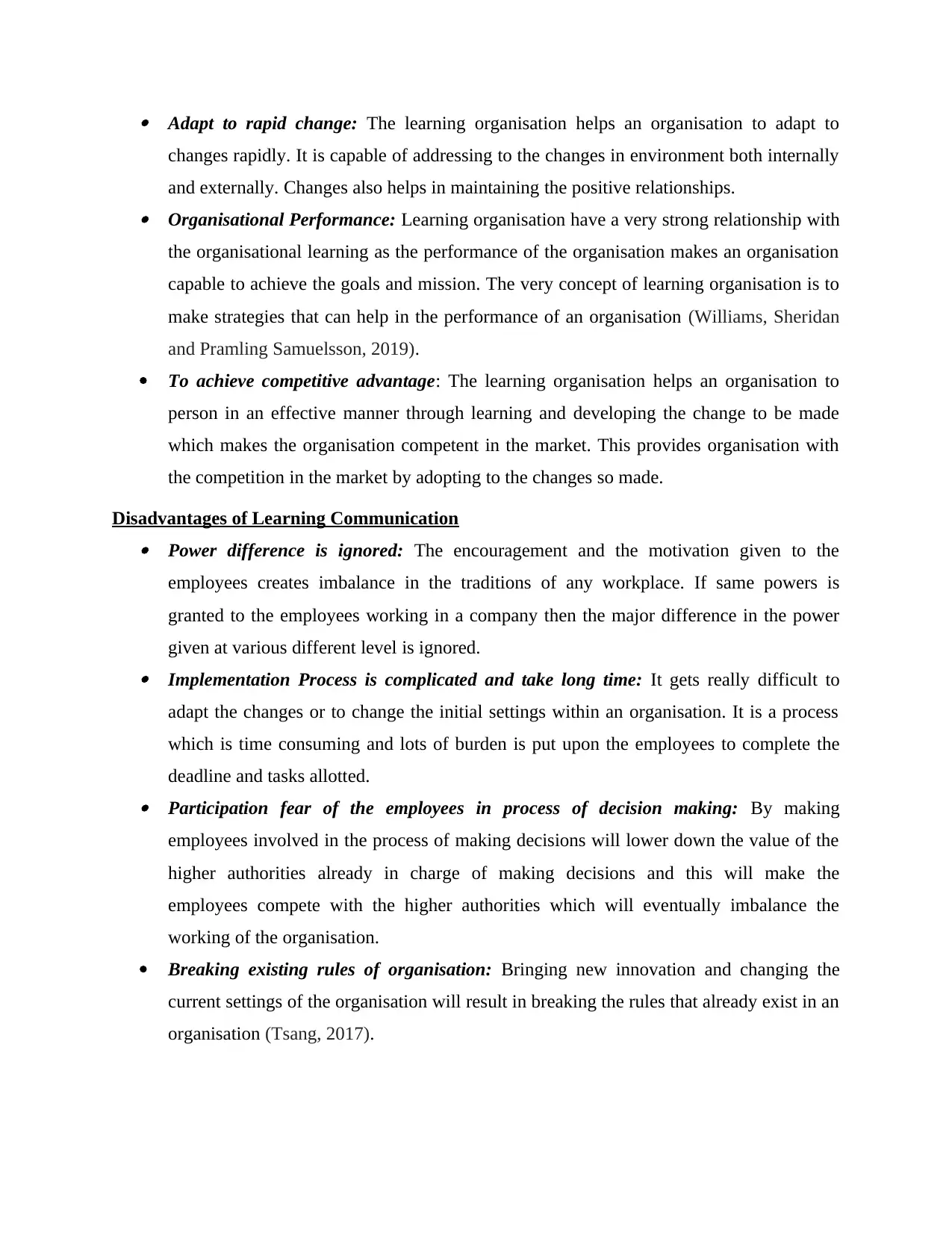
Adapt to rapid change: The learning organisation helps an organisation to adapt to
changes rapidly. It is capable of addressing to the changes in environment both internally
and externally. Changes also helps in maintaining the positive relationships. Organisational Performance: Learning organisation have a very strong relationship with
the organisational learning as the performance of the organisation makes an organisation
capable to achieve the goals and mission. The very concept of learning organisation is to
make strategies that can help in the performance of an organisation (Williams, Sheridan
and Pramling Samuelsson, 2019).
To achieve competitive advantage: The learning organisation helps an organisation to
person in an effective manner through learning and developing the change to be made
which makes the organisation competent in the market. This provides organisation with
the competition in the market by adopting to the changes so made.
Disadvantages of Learning Communication Power difference is ignored: The encouragement and the motivation given to the
employees creates imbalance in the traditions of any workplace. If same powers is
granted to the employees working in a company then the major difference in the power
given at various different level is ignored. Implementation Process is complicated and take long time: It gets really difficult to
adapt the changes or to change the initial settings within an organisation. It is a process
which is time consuming and lots of burden is put upon the employees to complete the
deadline and tasks allotted. Participation fear of the employees in process of decision making: By making
employees involved in the process of making decisions will lower down the value of the
higher authorities already in charge of making decisions and this will make the
employees compete with the higher authorities which will eventually imbalance the
working of the organisation.
Breaking existing rules of organisation: Bringing new innovation and changing the
current settings of the organisation will result in breaking the rules that already exist in an
organisation (Tsang, 2017).
changes rapidly. It is capable of addressing to the changes in environment both internally
and externally. Changes also helps in maintaining the positive relationships. Organisational Performance: Learning organisation have a very strong relationship with
the organisational learning as the performance of the organisation makes an organisation
capable to achieve the goals and mission. The very concept of learning organisation is to
make strategies that can help in the performance of an organisation (Williams, Sheridan
and Pramling Samuelsson, 2019).
To achieve competitive advantage: The learning organisation helps an organisation to
person in an effective manner through learning and developing the change to be made
which makes the organisation competent in the market. This provides organisation with
the competition in the market by adopting to the changes so made.
Disadvantages of Learning Communication Power difference is ignored: The encouragement and the motivation given to the
employees creates imbalance in the traditions of any workplace. If same powers is
granted to the employees working in a company then the major difference in the power
given at various different level is ignored. Implementation Process is complicated and take long time: It gets really difficult to
adapt the changes or to change the initial settings within an organisation. It is a process
which is time consuming and lots of burden is put upon the employees to complete the
deadline and tasks allotted. Participation fear of the employees in process of decision making: By making
employees involved in the process of making decisions will lower down the value of the
higher authorities already in charge of making decisions and this will make the
employees compete with the higher authorities which will eventually imbalance the
working of the organisation.
Breaking existing rules of organisation: Bringing new innovation and changing the
current settings of the organisation will result in breaking the rules that already exist in an
organisation (Tsang, 2017).

Relationship between organisational learning and learning organisation
Learning is a process which helps in bringing competition and flexibility in an
organisation. To cope up with various different challenges pertaining to the organisation, making
quick decision, technical competencies, analysing the situation of a business are few of the
competencies which are required by the organisation. With the help of a learning organisation,
various and continuous practices of the skills by the employees in the culture of organisational
learning, the skills are gathered by the employees via experiences so that the difficult situations
and challenges can be tackled. Both the concepts individually are very important for the
organisation as it provides with an advantage of sustainable competition. This leads to the
growth and success of the company by helping it to achieve its goals and missions.
Difference between Organisational Learning and Learning Organisation
Organisational learning mainly focuses on the learning which is done by the daily basis
knowledge and experience gained by the employees through various different organisational
activities (Byers, Imms and Hartnell-Young, 2018). On the other hand, learning organisation is
the structure and a process which mainly deals with the enhancement of the capabilities and the
competencies of the employees working in an organisation. This is the major difference between
the learning organisation and the organisational learning.
The below table shows the difference between the two on the basis of its meaning, type,
learning, responsibilities of manager and the focus.
Basis Organisational Learning Learning Organisation
Definition It is a process in which the act
of the employees is based upon
their experiences and the
knowledge which they have
gathered from daily activities
where they handle the
situations of the business.
It is the process which is
inbuilt. It is present within the
structure of an organisation
where its employees are
continuously working on to
improve their capability and its
development by which they
can handle the situations at the
business.
Type It is a type of process It is a Structure.
Learning is a process which helps in bringing competition and flexibility in an
organisation. To cope up with various different challenges pertaining to the organisation, making
quick decision, technical competencies, analysing the situation of a business are few of the
competencies which are required by the organisation. With the help of a learning organisation,
various and continuous practices of the skills by the employees in the culture of organisational
learning, the skills are gathered by the employees via experiences so that the difficult situations
and challenges can be tackled. Both the concepts individually are very important for the
organisation as it provides with an advantage of sustainable competition. This leads to the
growth and success of the company by helping it to achieve its goals and missions.
Difference between Organisational Learning and Learning Organisation
Organisational learning mainly focuses on the learning which is done by the daily basis
knowledge and experience gained by the employees through various different organisational
activities (Byers, Imms and Hartnell-Young, 2018). On the other hand, learning organisation is
the structure and a process which mainly deals with the enhancement of the capabilities and the
competencies of the employees working in an organisation. This is the major difference between
the learning organisation and the organisational learning.
The below table shows the difference between the two on the basis of its meaning, type,
learning, responsibilities of manager and the focus.
Basis Organisational Learning Learning Organisation
Definition It is a process in which the act
of the employees is based upon
their experiences and the
knowledge which they have
gathered from daily activities
where they handle the
situations of the business.
It is the process which is
inbuilt. It is present within the
structure of an organisation
where its employees are
continuously working on to
improve their capability and its
development by which they
can handle the situations at the
business.
Type It is a type of process It is a Structure.
⊘ This is a preview!⊘
Do you want full access?
Subscribe today to unlock all pages.

Trusted by 1+ million students worldwide
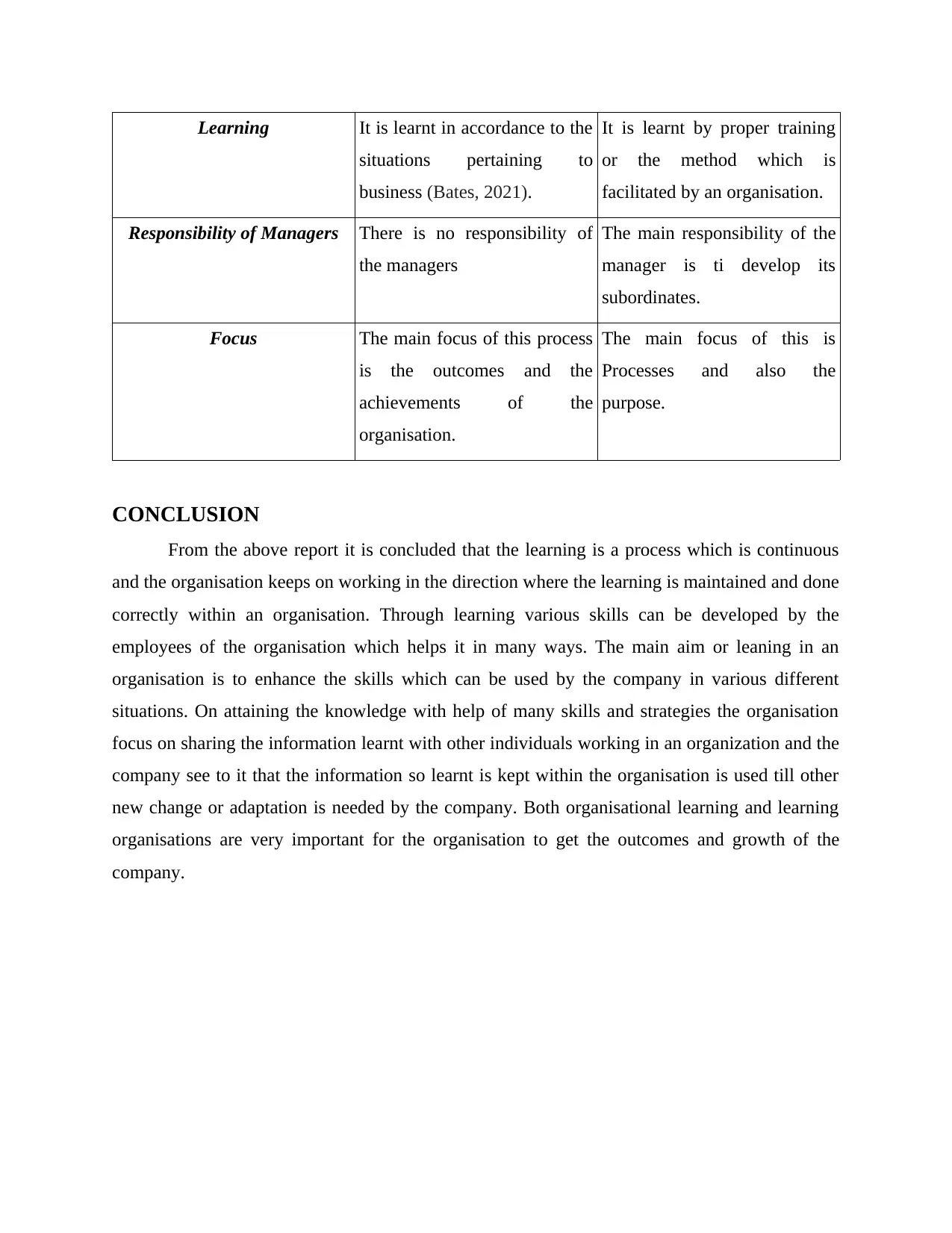
Learning It is learnt in accordance to the
situations pertaining to
business (Bates, 2021).
It is learnt by proper training
or the method which is
facilitated by an organisation.
Responsibility of Managers There is no responsibility of
the managers
The main responsibility of the
manager is ti develop its
subordinates.
Focus The main focus of this process
is the outcomes and the
achievements of the
organisation.
The main focus of this is
Processes and also the
purpose.
CONCLUSION
From the above report it is concluded that the learning is a process which is continuous
and the organisation keeps on working in the direction where the learning is maintained and done
correctly within an organisation. Through learning various skills can be developed by the
employees of the organisation which helps it in many ways. The main aim or leaning in an
organisation is to enhance the skills which can be used by the company in various different
situations. On attaining the knowledge with help of many skills and strategies the organisation
focus on sharing the information learnt with other individuals working in an organization and the
company see to it that the information so learnt is kept within the organisation is used till other
new change or adaptation is needed by the company. Both organisational learning and learning
organisations are very important for the organisation to get the outcomes and growth of the
company.
situations pertaining to
business (Bates, 2021).
It is learnt by proper training
or the method which is
facilitated by an organisation.
Responsibility of Managers There is no responsibility of
the managers
The main responsibility of the
manager is ti develop its
subordinates.
Focus The main focus of this process
is the outcomes and the
achievements of the
organisation.
The main focus of this is
Processes and also the
purpose.
CONCLUSION
From the above report it is concluded that the learning is a process which is continuous
and the organisation keeps on working in the direction where the learning is maintained and done
correctly within an organisation. Through learning various skills can be developed by the
employees of the organisation which helps it in many ways. The main aim or leaning in an
organisation is to enhance the skills which can be used by the company in various different
situations. On attaining the knowledge with help of many skills and strategies the organisation
focus on sharing the information learnt with other individuals working in an organization and the
company see to it that the information so learnt is kept within the organisation is used till other
new change or adaptation is needed by the company. Both organisational learning and learning
organisations are very important for the organisation to get the outcomes and growth of the
company.
Paraphrase This Document
Need a fresh take? Get an instant paraphrase of this document with our AI Paraphraser
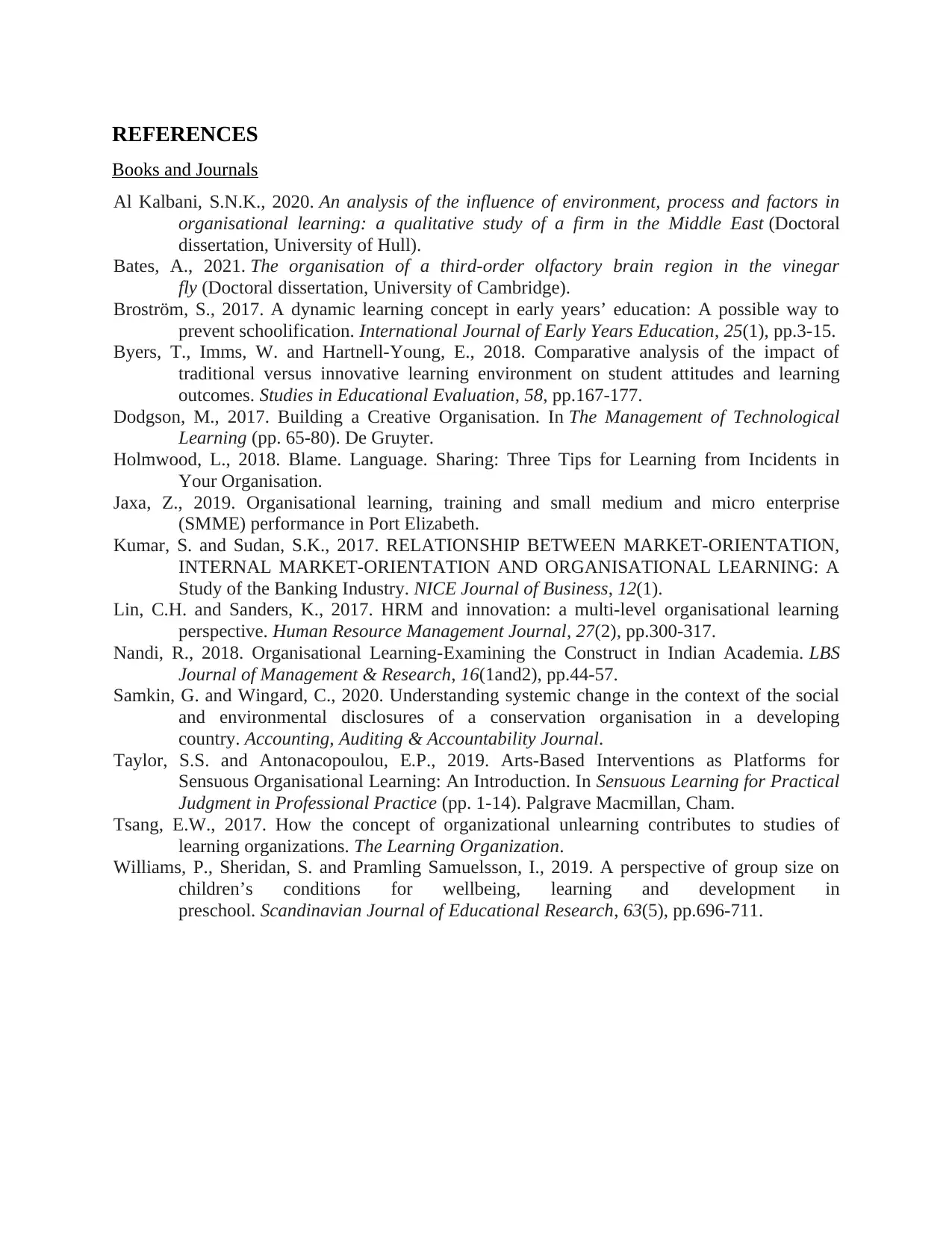
REFERENCES
Books and Journals
Al Kalbani, S.N.K., 2020. An analysis of the influence of environment, process and factors in
organisational learning: a qualitative study of a firm in the Middle East (Doctoral
dissertation, University of Hull).
Bates, A., 2021. The organisation of a third-order olfactory brain region in the vinegar
fly (Doctoral dissertation, University of Cambridge).
Broström, S., 2017. A dynamic learning concept in early years’ education: A possible way to
prevent schoolification. International Journal of Early Years Education, 25(1), pp.3-15.
Byers, T., Imms, W. and Hartnell-Young, E., 2018. Comparative analysis of the impact of
traditional versus innovative learning environment on student attitudes and learning
outcomes. Studies in Educational Evaluation, 58, pp.167-177.
Dodgson, M., 2017. Building a Creative Organisation. In The Management of Technological
Learning (pp. 65-80). De Gruyter.
Holmwood, L., 2018. Blame. Language. Sharing: Three Tips for Learning from Incidents in
Your Organisation.
Jaxa, Z., 2019. Organisational learning, training and small medium and micro enterprise
(SMME) performance in Port Elizabeth.
Kumar, S. and Sudan, S.K., 2017. RELATIONSHIP BETWEEN MARKET-ORIENTATION,
INTERNAL MARKET-ORIENTATION AND ORGANISATIONAL LEARNING: A
Study of the Banking Industry. NICE Journal of Business, 12(1).
Lin, C.H. and Sanders, K., 2017. HRM and innovation: a multi‐level organisational learning
perspective. Human Resource Management Journal, 27(2), pp.300-317.
Nandi, R., 2018. Organisational Learning-Examining the Construct in Indian Academia. LBS
Journal of Management & Research, 16(1and2), pp.44-57.
Samkin, G. and Wingard, C., 2020. Understanding systemic change in the context of the social
and environmental disclosures of a conservation organisation in a developing
country. Accounting, Auditing & Accountability Journal.
Taylor, S.S. and Antonacopoulou, E.P., 2019. Arts-Based Interventions as Platforms for
Sensuous Organisational Learning: An Introduction. In Sensuous Learning for Practical
Judgment in Professional Practice (pp. 1-14). Palgrave Macmillan, Cham.
Tsang, E.W., 2017. How the concept of organizational unlearning contributes to studies of
learning organizations. The Learning Organization.
Williams, P., Sheridan, S. and Pramling Samuelsson, I., 2019. A perspective of group size on
children’s conditions for wellbeing, learning and development in
preschool. Scandinavian Journal of Educational Research, 63(5), pp.696-711.
Books and Journals
Al Kalbani, S.N.K., 2020. An analysis of the influence of environment, process and factors in
organisational learning: a qualitative study of a firm in the Middle East (Doctoral
dissertation, University of Hull).
Bates, A., 2021. The organisation of a third-order olfactory brain region in the vinegar
fly (Doctoral dissertation, University of Cambridge).
Broström, S., 2017. A dynamic learning concept in early years’ education: A possible way to
prevent schoolification. International Journal of Early Years Education, 25(1), pp.3-15.
Byers, T., Imms, W. and Hartnell-Young, E., 2018. Comparative analysis of the impact of
traditional versus innovative learning environment on student attitudes and learning
outcomes. Studies in Educational Evaluation, 58, pp.167-177.
Dodgson, M., 2017. Building a Creative Organisation. In The Management of Technological
Learning (pp. 65-80). De Gruyter.
Holmwood, L., 2018. Blame. Language. Sharing: Three Tips for Learning from Incidents in
Your Organisation.
Jaxa, Z., 2019. Organisational learning, training and small medium and micro enterprise
(SMME) performance in Port Elizabeth.
Kumar, S. and Sudan, S.K., 2017. RELATIONSHIP BETWEEN MARKET-ORIENTATION,
INTERNAL MARKET-ORIENTATION AND ORGANISATIONAL LEARNING: A
Study of the Banking Industry. NICE Journal of Business, 12(1).
Lin, C.H. and Sanders, K., 2017. HRM and innovation: a multi‐level organisational learning
perspective. Human Resource Management Journal, 27(2), pp.300-317.
Nandi, R., 2018. Organisational Learning-Examining the Construct in Indian Academia. LBS
Journal of Management & Research, 16(1and2), pp.44-57.
Samkin, G. and Wingard, C., 2020. Understanding systemic change in the context of the social
and environmental disclosures of a conservation organisation in a developing
country. Accounting, Auditing & Accountability Journal.
Taylor, S.S. and Antonacopoulou, E.P., 2019. Arts-Based Interventions as Platforms for
Sensuous Organisational Learning: An Introduction. In Sensuous Learning for Practical
Judgment in Professional Practice (pp. 1-14). Palgrave Macmillan, Cham.
Tsang, E.W., 2017. How the concept of organizational unlearning contributes to studies of
learning organizations. The Learning Organization.
Williams, P., Sheridan, S. and Pramling Samuelsson, I., 2019. A perspective of group size on
children’s conditions for wellbeing, learning and development in
preschool. Scandinavian Journal of Educational Research, 63(5), pp.696-711.
1 out of 11
Related Documents
Your All-in-One AI-Powered Toolkit for Academic Success.
+13062052269
info@desklib.com
Available 24*7 on WhatsApp / Email
![[object Object]](/_next/static/media/star-bottom.7253800d.svg)
Unlock your academic potential
Copyright © 2020–2025 A2Z Services. All Rights Reserved. Developed and managed by ZUCOL.





